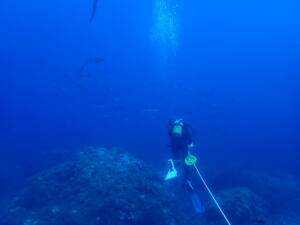Fish vulnerable to fishing have doubled in the Illa de l’Aire Marine Reserve after five years of protection!

Scientific monitoring by the IEO and OBSAM confirms the benefits of protecting this area, although it warns of risks due to the reduction of the protected area and the lack of surveillance. The reserve, declared in April 2019 by the Government of the Balearic Islands, aims to recover fishery resources and conserve essential habitats in the southeast of Menorca.
A study led by the Spanish Institute of Oceanography (IEO-CSIC), through the Jaume Ferrer Research Station, and the Socio-environmental Observatory of Menorca (OBSAM-IME) reveals a significant improvement in fish populations vulnerable to fishing in the Marine Reserve of Isla del Aire, five years after its designation. The report highlights a 96% increase in abundance and a 161% increase in biomass in the areas under the highest level of protection.
In July 2024, the fifth monitoring campaign of fish vulnerable to fishing was carried out in the Marine Reserve of Isla del Aire, five years after its designation. During the campaign, 108 visual censuses were conducted, covering a total of 27,000 square metres of rocky seabed at two depth strata: shallow (between 5 and 15 metres) and deep (between 16 and 26 metres); and within three management levels: integral reserve (closed to fishing except from the shore), partial reserve (where some fishing activities are allowed), and control zone (outside the Reserve).
The report confirms that, in the shallow stratum of the integral reserve zone, the average abundance of fish has increased by 96% and biomass by 161% since the start of the study. This improvement is not observed in zones open to fishing, where values have remained stable.
In the deep stratum, results are promising but less conclusive, mainly due to a change in the zoning of the reserve in 2022 that complicates the interpretation of results. Even so, in 2024 the integral reserve zone, within this depth stratum, shows an increase in abundance and biomass compared to the control zone by 1.6 and 2 times, respectively.
Although abundance and biomass have improved within the reserve, populations are mainly composed of juvenile individuals, meaning that the average size remains below that of fully grown adults of the various species. Thus, during the five years since the reserve was declared, no significant changes have been detected in the average sizes or size ranges of the studied species, suggesting that the largest and longest-living individuals have not yet had sufficient time to establish themselves in the ecosystem. In recent sampling years, and across both depth strata, a notable increase has been observed in the contribution to total biomass by high trophic level species, particularly the grouper.
A regulatory change in 2022 reduced the area of integral protection by 22%, significantly decreasing the availability of protected deep rocky seabeds. According to the scientific team, this reduction, combined with the lack of permanent surveillance within the reserve, jeopardises its effectiveness for the recovery and conservation of fish species vulnerable to fishing.
The results of this report highlight the need to expand the percentage of suitable rocky habitat for the adult reproductive population within the marine reserve’s highly protected area. Similarly, it is noted that fishing pressure in adjacent zones (partial reserve and control zone) remains high.
History of the Marine Reserve of Isla del Aire
The Marine Reserve of Isla del Aire was declared in April 2019 by the Government of the Balearic Islands as part of the Network of Marine Reserves of the Balearic Islands. Its goal is the recovery of fishery resources and the conservation of essential habitats in the southeast of Menorca. The reserve covers 7.2 km² and includes two distinct management zones: one with special protection for diving, where only shore-based fishing is permitted (integral reserve), and another where artisanal and recreational fishing is regulated (partial reserve). Unlike other marine reserves managed for fisheries in the Balearic Islands, the Marine Reserve of Isla del Aire does not have an area completely closed to fishing. In 2022, the zoning of the reserve was modified, reducing the area of the integral reserve under strictest protection by 22%.
This project has been developed within the framework of the marine environment scientific monitoring programmes of the Jaume Ferrer Research Station in La Mola and the Socio-environmental Observatory of Menorca (OBSAM-IME), with the approval of the Directorate General for Fisheries and the Marine Environment of the Government of the Balearic Islands. The Jaume Ferrer Station is co-funded by the Ministry of Education and Universities of the Balearic Government and by the Spanish Institute of Oceanography. OBSAM-IME has been funded by Menorca Preservation since the start of the project (2018–2022) and by the Menorca Biosphere Reserve Agency of the Island Council of Menorca (2018, 2019, 2020 and 2024).